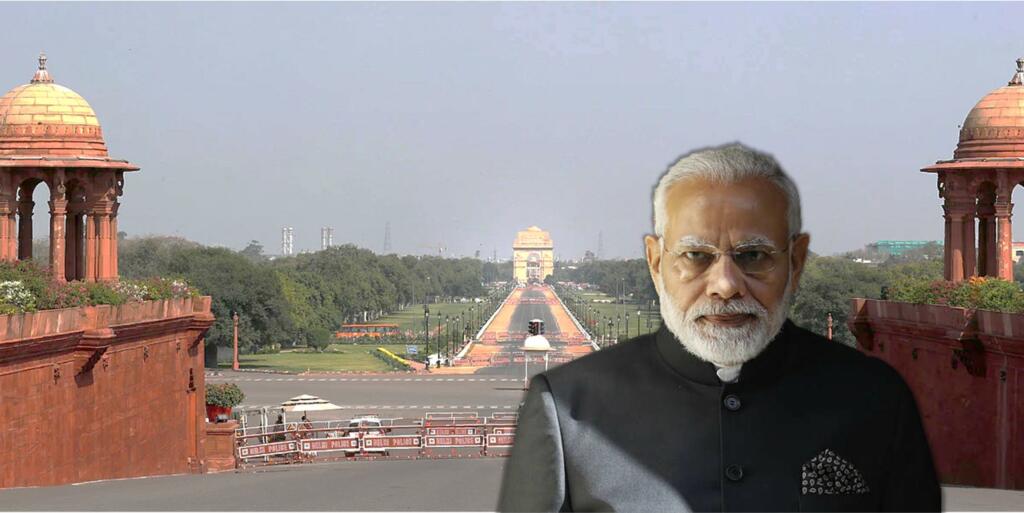A civilisation state, whose populace forget what exactly made it great in the first place, starts disintegrating. No point in living together if there is no common historical root connecting everyone. This is one of the main reasons why PM Modi is getting rid of symbols proclaiming supremacy of Mughals and Gora and Bhura Sahebs.
Rajpath to Kartavya Path
The Modi government has decided to rename Rajpath and the Central Vista lawns. Now the renewed name is inclusive of the Indic moral system. Rajpath, the name whose pronunciation gave a subconscious signal of exclusive zone of kings and inaccessible rulers will now be called Kartavya Path.
The new name gives the message that the place is reserved for those who do their duty diligently and not for those who use it to form a modern-day monarchy. It is also a message to politicians that they will be here only for 5 years and until they fulfil their duties, they will not be brought back.
Kartavya Path is not the only renamed path. Earlier Race Course Road was renamed Lok Kalyan Marg. Similarly, Aurangzeb Road was also changed to APJ Abdul Kalam Road. Dalhousie Road was changed to Dara Shikoh Road.
The Kartavya Path move to rename is in line with PM Modi’s Independence Day speech of getting over colonial hangover in our polity. PM Modi and his Cabinet understands that symbolism has great significance in a country’s march towards greatness. The understanding started to get reflected in the first few months of the Modi Cabinet as well.
Planning Commission to NITI Aayog
One of the first and possibly the most revolutionary decisions was to change the way in which policymakers used to brainstorm. The Planning Commission, a relic of Socialist era and an outdated concept, had evolved into having too much power into the hands of Centre.
The commission was effectively creating a top-down hierarchy in Indian polity. The Modi government dismantled it and introduced NITI Aayog, with the vision of Maximum Governance, Minimum Government, echoing the spirit of ‘Cooperative Federalism’, a bottom-up and more inclusive approach.
Archaic laws outta books
Another challenge in the implementation of policies was the removal of unnecessary and impractical laws. These laws were introduced by the British in order to have maximum control over our population. Successive governments after Independence found them useful in sustaining their hegemony. They only repealed 1,301 such laws from the country.
During his campaign for the 2014 general elections, Prime Minister Narendra Modi had emphasised how old laws are creating hurdles in the path of the country’s development. He had promised to repeal 10 obsolete laws for every new law his government would introduce. By the end of 2019, the Modi government had repealed 1,582 such laws, which were just a burden on rule books. It paved the way for more trust between the public and the government.
Self-attestation
The trust factor was also introduced by a self-attestation mechanism. Earlier, common folks had to visit sarkari babus in order to communicate to the government that he is a good citizen.
It was a straightforward humiliation of individual dignity and was introduced by the British to keep Indians enslaved to their trusted babus. Unfortunately, things did not change until PM Modi came to power. Now people have to self-attest their documents and the government trusts them.
Introduction of CDS
Not only with the public, the Modi government also developed cordial relationships with the Armed Forces. Earlier, governments had not been acting on the proposal of unified command under a single Armed Forces’ chief. Obviously, the fear was that if all three forces operated on one command, unpopular policies of the government could be used as an excuse to affect a coup.
The fear compromised our national security. The Modi government changed this attitude with the creation of a post called Chief of Defence Staff (CDS). Now all 3 units of Armed Forces have one centralised command and there is extremely less chance of bureaucratic hurdles. The decision gave more teeth to our Forces.
Navy Insignia and Emblem
The practice of giving more teeth to Forces by introducing modernisation was actually started by Shivaji Maharaj. He was the one who made Indian Naval power into what it is today. Naturally, it was absurd that St. George’s cross was still its insignia.
The Modi government changed it. The new Insignia is more in line with India’s own Naval firepower, which was given its modern teeth by Shivaji Maharaj. It is a beautiful tribute to his contribution.
With increasing power, Babbar Sher can’t be allowed to be showcased as weak. So, the Modi government changed the national emblem. Earlier our national emblem was a lion that looked more defensive rather than a proactive one. In the new emblem more ferocious teeth were present, to showcase its aggressive instincts. This was the symbolic arrival of new India, something which our Foreign Minister S. Jaishankar always talks about.
A civilisational journey is never complete. Nothing is static here. But the spirit of aggression needs to be permanently imbibed in the psyche. All these changes are step in that direction.
Support TFI:
Support us to strengthen the ‘Right’ ideology of cultural nationalism by purchasing the best quality garments from TFI-STORE.COM
